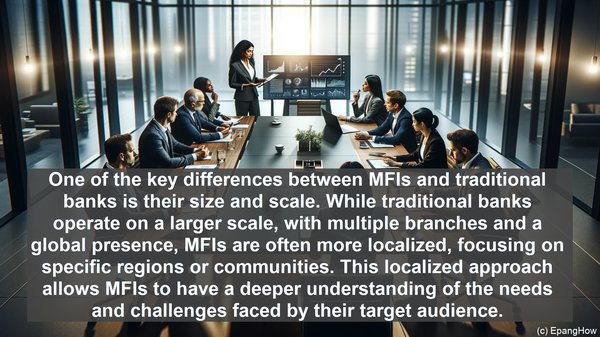Introduction: The Diverse Financial Landscape
Hello and welcome to our article on microfinance institutions and traditional banks. When it comes to financial services, there’s more than meets the eye. Let’s dive in!
Understanding Microfinance Institutions
Microfinance institutions, often referred to as MFIs, are specialized financial entities that cater to the needs of individuals and small businesses who may not have access to traditional banking services. They focus on providing small loans, savings accounts, and other financial products to this underserved segment of the population. What sets them apart is their mission to promote financial inclusion and alleviate poverty.
The Traditional Banking Landscape
On the other hand, traditional banks have been the backbone of the financial system for centuries. They offer a wide range of services, including savings and checking accounts, loans, mortgages, and investment options. These banks are often larger in scale, with a broader customer base, and are regulated by central banking authorities.

Size and Scale: A Matter of Reach
One of the key differences between MFIs and traditional banks is their size and scale. While traditional banks operate on a larger scale, with multiple branches and a global presence, MFIs are often more localized, focusing on specific regions or communities. This localized approach allows MFIs to have a deeper understanding of the needs and challenges faced by their target audience.
The Loan Perspective: Tailoring to Different Needs
When it comes to loans, both MFIs and traditional banks play a crucial role. However, the approach and requirements may vary. Traditional banks typically have stringent criteria for loan approval, including credit history, collateral, and a detailed business plan. In contrast, MFIs often adopt a more flexible approach, considering factors such as character, community support, and the potential impact of the loan on the borrower’s livelihood.
Interest Rates: Balancing Risk and Affordability
Interest rates are a critical aspect of any financial transaction. Traditional banks, being more established and having a diverse customer base, often offer loans at lower interest rates. This is due to their ability to manage risk and access cheaper sources of funding. MFIs, on the other hand, may have higher interest rates to compensate for the higher risk associated with lending to underserved individuals or businesses.
Beyond Loans: The Range of Services
While loans are a significant part of the services offered by both MFIs and traditional banks, there’s more to it. Traditional banks provide a comprehensive suite of services, including investment management, insurance, and financial advisory. MFIs, while primarily focused on credit, also offer savings accounts, micro-insurance, and financial literacy programs, aiming to empower their clients with a holistic approach to financial well-being.

The Impact Factor: Social vs. Commercial
Perhaps one of the most significant differences between MFIs and traditional banks is their underlying mission. While traditional banks operate with a profit-driven approach, MFIs have a dual objective of financial sustainability and social impact. By providing financial services to the underserved, MFIs contribute to poverty reduction, women empowerment, and overall economic development at the grassroots level.
